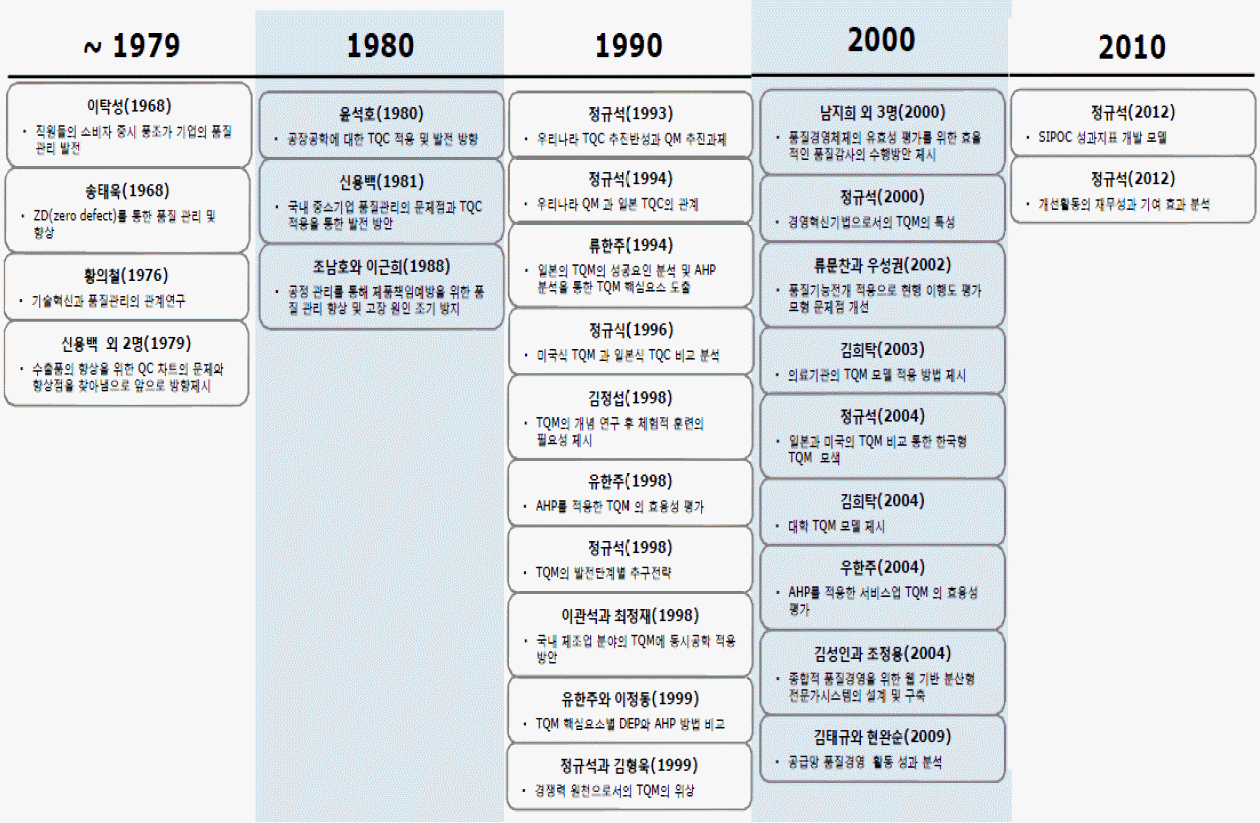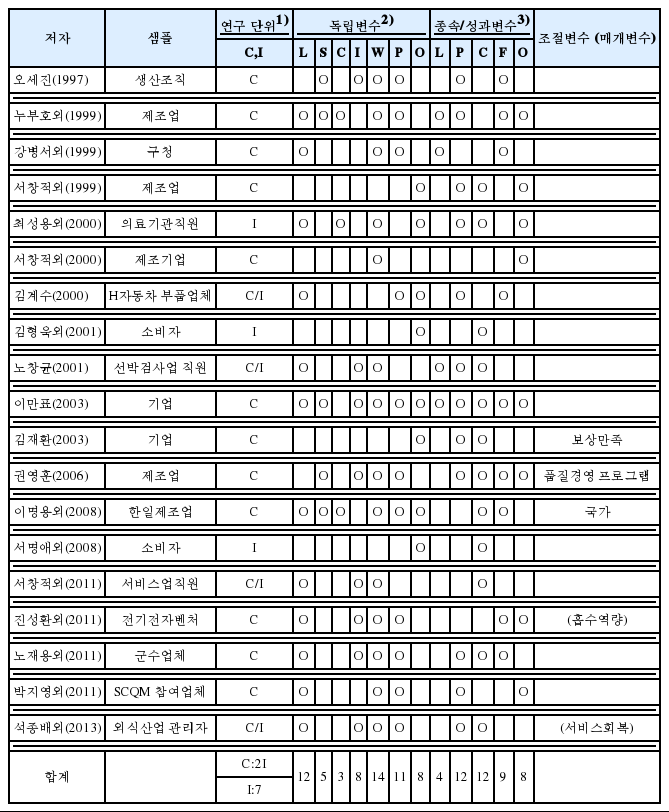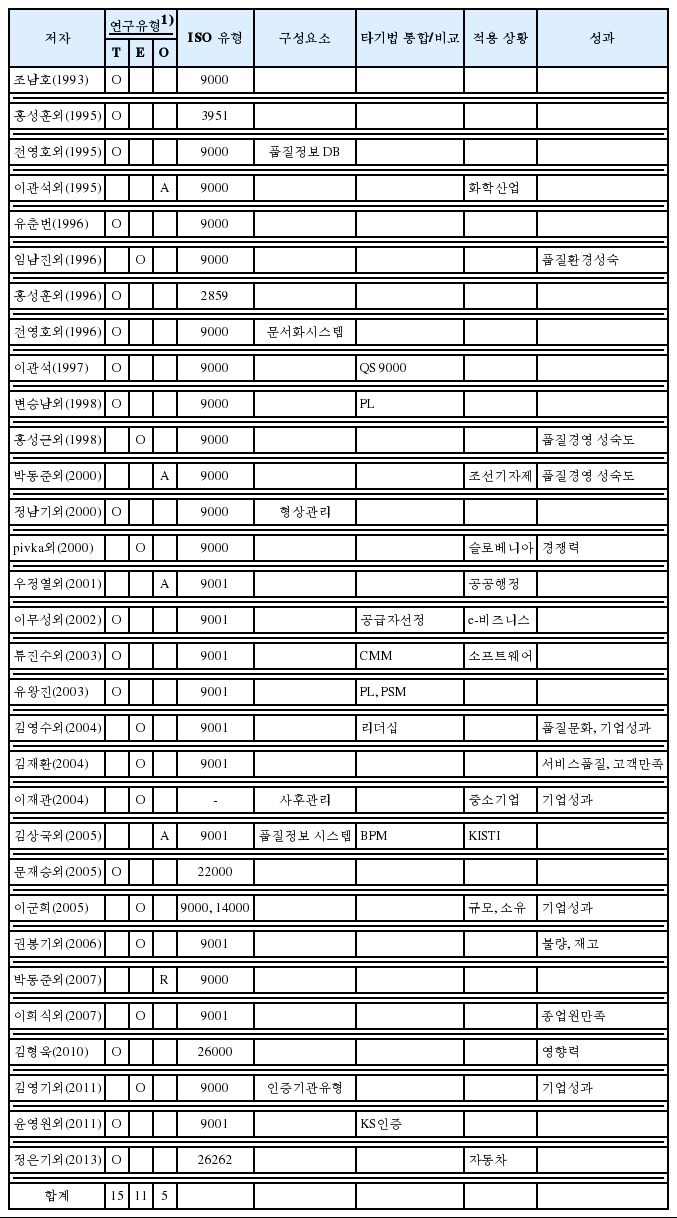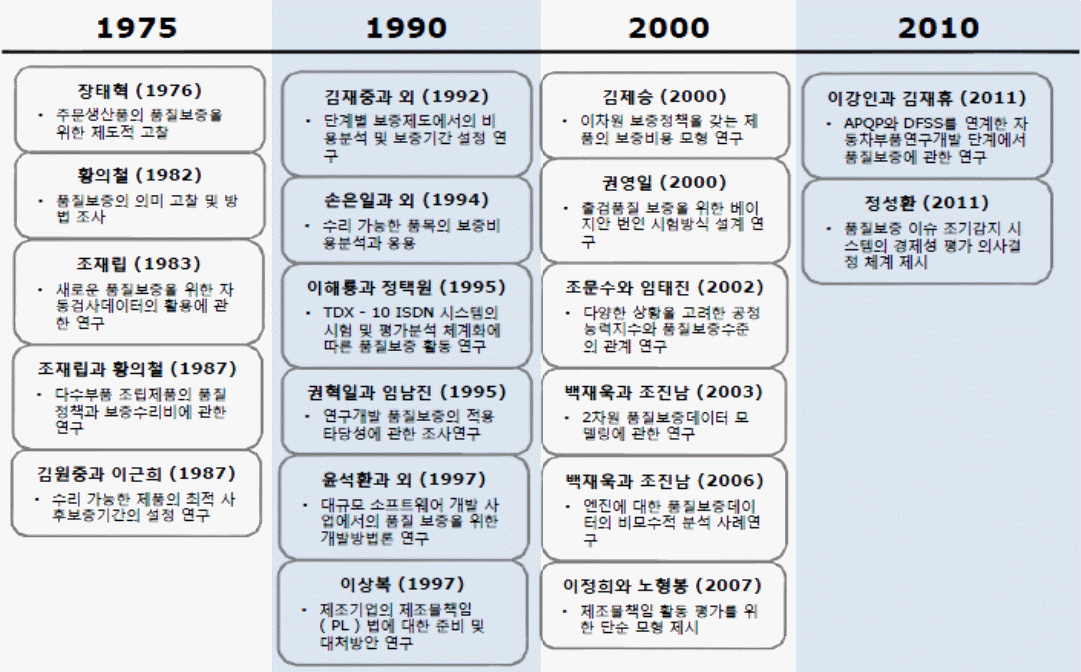References
Ahan P. S.. 1980;HowAhan, P.S. 1980. "How to be Awarded 79 National Quality Management Award: Sam Yang Tire Company Case. Journal of the Korean Society for Quality Management 8(1):32–36.
Baik J. W.. 2003;Two-Dimensional Warranty Data Modelling. Journal of the Korean Society for Quality Management 31(4):219–225.
Baik J. W., Jo J. N.. 2006;Nonparametric Analysis of Warranty Data on Engine: Case Study. Journal of the Korean Society for Quality Management 34(1):40–47.
Byun S. N., Lee D. H.. 1998;Implementation og Quality management Policy and ISO 9000 Series under Product Liability Law. Journal of the Korean Society for Quality Management 26(1):27–47.
Cho J. L.. 1983;A Study on the use of Automatic testing Data for Updating Quality Assurance Models. Journal of the Korean Society for Quality Management 11(2):25–31.
Cho J. L., Whang E. C.. 1987;A Study on Quality Policy and Warranty Cost in Multi-components Assembly Product. Journal of the Korean Society for Quality Management 15(1):2–12.
Cho M., Lim T.. 2002;The Relation between the Process Capability Index and the Assurance level Considering various Conditions. Journal of the Korean Society for Quality Management 30(2):130–151.
Cho N. H.. 1993;Controversial Point and Improvement Policy of the Certified system for Quality - Based on the Relation with ISO 9000 Series. Journal of the Korean Society for Quality Management 21(1):1–10.
Cho N. H., Lee K. H.. 1988;A Study on the Quality Control Method for the Product Liability Prevention. Journal of the Korean Society for Quality Management 21(1):1–31.
Cho Y. R.. 1980;How to be Awarded 79 National Quality Management Award: Dong Yang Nylon Company Case. Journal of the Korean Society for Quality Management 8(2):29–35.
Choi S. Y., Jung H. K.. 2000;Effects of Ownership Types, Geographical Locations and Leadership Types of mediacal Service Institutions on TQM Performance. Journal of the Korean Society for Quality Management 28(1):151–174.
Chun Y. H., Lee K. S.. 1995;A Study on Quality Information data Base for ISO 9000 Series Certification. Journal of the Korean Society for Quality Management 23(1):64–73.
Chun Y. H., Baek I. G.. 1996;Development of ISO 9000 Series Documentation System Using the Documentation Structure Analysis and Work Flow Analysis. Journal of the Korean Society for Quality Management 24(4):112–123.
Chung K. S.. 1993;Suggestions for Quality Management Reflecting TQC in Korea. Journal of the Korean Society for Quality Management 21(1):1–31.
Chung K. S.. 1994;Does QM lie on the Continuity of TQC? Journal of the Korean Society for Quality Management 22(3):1–15.
Chung K. S.. 1996;A Comparison between Japanese TQC and American TQM. Journal of the Korean Society for Quality Management 24(2):1–24.
Chung K. S.. 1998;The Intended Strategy of TQM by Developing Stages. Journal of the Korean Society for Quality Management 26(4):1–28.
Chung K. S., Kim H.W.. 1999;TQM's Position as the Source of the Competitiveness: In View of International Competitiveness of Japanese Corporations. Journal of the Korean Society for Quality Management 27(4):67–94.
Chung K. S.. 2000;TQM as a Innovation Tool. Journal of the Korean Society for Quality Management 28(4):132–150.
Chung K. S.. 2004;In Search of Korean TQM through the Comparison between American and Japanese TQM. Journal of the Korean Society for Quality Management 32(3):1–9.
Chung K. S., Kang Y.T.. 2007;Continuous Improvement, Innovation, and Learning in MBNQA. Journal of the Korean Society for Quality Management 35(1):73–80.
Chung K. S.. 2009;Analyis on Financial Performance of Improvement Activities. Journal of the Korean Society for Quality Management 37(3):1–9.
Chung K. S., Yoon S.W.. 2012;Development of KPI by SIPOC Model. Journal of the Korean Society for Quality Management 40(3):394–405.
Chung N., Choi J-G, Kim Y-S, Park S-K. 2000;an Implementation of Configuration management in ISO 9000 Quality system. Journal of the Korean Society for Quality Management 28(2):176–191.
Han S. H., Chung K. S., Hong S. P.. 2014;Effect of Quality Management on the Performance: Focusing Manufacturing Companies Awarding National Quality Award. Journal of the Korean Society for Quality Management 42(4):729–746.
Hong S-H., Lee S-W.. 1995;ISO 3951, Sampling Procedures and Charts for Inspection by Variables for Percent Nonconforming. Journal of the Korean Society for Quality Management 23(1):1–14.
Hong S-H., Lee S-W.. 1996;ISO 2859-1 (1989), Sampling Plans Indexed by Acceptable Quality Level for Lot-by-Lot Inspection. Journal of the Korean Society for Quality Management 24(3):77–93.
Hong S-K., Riew M-C.. 1998;Analysis of the Effect of ISO 9000 Certification Based on Crosby's Quality Management Grid. Journal of the Korean Society for Quality Management 26(2):1–16.
Hwang E. C.. 1976;Technology Innovation and Role of Quality Management. Journal of the Korean Society for Quality Management 4(1):3–4.
Hwang E. C.. 1982;Quality Assurance. Journal of the Korean Society for Quality Management 10(1):27–41.
Jang T. H.. 1976;A Review on the Institution for Quality Assurance of Products Ordered. Journal of the Korean Society for Quality Management 4(1):10–12.
Jin S., Lee C., Lee D.. 2011;The Effect of Quality Management and Absorptive Capacity on the Competitiveness of Small and Medium Venture Manufacturing Company in Electric and Electronic Industry. Journal of the Korean Society for Quality Management 39(2):292–304.
Jung E-K., Kim D-C.. 2013;Automotive Functional Safety-ISO 26262 and Its Countermeasures. Journal of the Korean Society for Quality Management 41(2):185–196.
Jung S. H.. 2012;Economic Evaluation of Early Detection System for Warranty Issues. Journal of the Korean Society for Quality Management 40(1):39–48.
Kang B-S., Kim G-S.. 1999;A Study on the Development of quality Management System Model and its Application in the Public Service Sector. Journal of the Korean Society for Quality Management 27(3):17–39.
Kim C. S., Murthy D. N. O.. 2000;Warranty Cost models for a Product with a Two-Dimensional Warranty Policy. Journal of the Korean Society for Quality Management 28(1):57–77.
Kim D-H., Ko S-B., Jang Y-J.. 2002;A Study on the TQM and 6 Sigma Management. Journal of the Korean Society for Quality Management 30(3):120–138.
Kim K. S.. 2000;A Study on Quality Management Performance of the Strategic Supply chain Management between Parts Enterprise and the Manufacturing Industry. Journal of the Korean Society for Quality Management 28(4):204–222.
Kim H.. 2003;A Study on TQM of Health Care Sector. Journal of the Korean Society for Quality Management 31(2):82–97.
Kim H.. 2004;A Study on TQM in College Education. Journal of the Korean Society for Quality Management 32(4):103–112.
Kim H. W., Jung I. J.. 2001;A Study on Vitalization of the Activities of Online Shopping Mall in Quality Management System. Journal of the Korean Society for Quality Management 29(2):54–75.
Kim H. W.. 2010;Effect Analysis and Effective Responsive Measures of ISO 26000 Global Standard Establishment and Its Implementation in Korea. Journal of the Korean Society for Quality Management 38(2):236–247.
Kim J. H.. 2003;A Study on the Effects of Rewards Factors on performance of TQM. Journal of the Korean Society for Quality Management 31(4):64–80.
Kim J. H.. 2004;A Study on the Effects of ISO 9001 Certification Factors on Performance of service Quality and Customer Satisfaction. Journal of the Korean Society for Quality Management 32(4):64–77.
Kim J. J., Jang J. S., Kim W. J.. 1992;Cost Analysis and Period Determination in Stepdown Warranty Policy. Journal of the Korean Society for Quality Management 20(1):39–47.
Kim J.. 1998;Experiential Traning in TQM. Journal of the Korean Society for Quality Management 26(3):17–30.
Kim S-K., Shin S-H., Lee Y-S., Chung T-Y.. 2005;A Study on Establishing a ISO 9001 Quality Management System using Information Technology. Journal of the Korean Society for Quality Management 33(2):13–21.
Kim S-I., Cho J-Y.. 2004;Designing and Implementation of a Web-based Expert System for the TQM. Journal of the Korean Society for Quality Management 32(2):168–190.
Kim T. K., Hyun O. S.. 2009;Performance Analysis for Supply Chain Quality Management. Journal of the Korean Society for Quality Management 37(1):69–79.
Kim W. J., Lee K. H.. 1987;Optimal Warranty Period for Repairable Goods. Journal of the Korean Society for Quality Management 15(1):13–19.
Kim Y-K., Park Y-T.. 2001;An Empirical Study on the Difference in Management Performance of Small and Medium Size Companies Due to the Types of ISO 9000 Quality Management Systems Certification Agencies. Journal of the Korean Society for Quality Management 39(2):179–187.
Kim Y. K., Park B. H.. 1987;A Study on the Quality Control System for Manufacturing Industry of Jeon-buk Area. Journal of the Korean Society for Quality Management 15(1):33–46.
Kim Y-S., Yoon J-H.. 2004;The Effect of the Organizational Leadership and Corporate Culture Types, ISO 9001 Systems, the Quality Culture Formation on the Corporate Performance. Journal of the Korean Society for Quality Management 32(2):37–58.
Kwon B-G., Yun W. Y., Kim H-G.. 2006;Effect Analysis of Certification of ISO 9000 Quality management System. Journal of the Korean Society for Quality Management 34(2):1–11.
Kwon H-I., Lim N-J.. 1995;Feasibility Study on the Application of Quality Assurance in Research and Development. Journal of the Korean Society for Quality Management 23(1):74–94.
Kwon Y.. 2006;The Moderated Effect of Quality Managemnt Program on the Efforts of Quality Management to Performance. Journal of the Korean Society for Quality Management 34(3):41–50.
Kwon Y-I.. 1997;A Comparative Survey on Quality Management Activities of Each Industry to Strengthen Competitive Power of Small-medium Companies. Journal of the Korean Society for Quality Management 25(4):154–166.
Kwon Y-I.. 2000;A Bayesian Burn-in procedure Guaranteeing Outgoing Quality of a Product. Journal of the Korean Society for Quality Management 28(4):67–74.
Lee G-H.. 2006;An Empirical Study on the Effectiveness of ISO 9000/14000 Registered Companies in Korea. Journal of the Korean Society for Quality Management 34(2):98–106.
Lee H., Jeong T.. 1995;Systematic Quality Assurance Activity for TDX-1- ISDN Switching System. Journal of the Korean Society for Quality Management 23(1):127–141.
Lee H-S., Choi Y-J., Kim Y-R.. 2007;A Study on the Influence of ISO 9001 Quality Management System on Employee's Satisfaction. Journal of the Korean Society for Quality Management 35(4):16–25.
Lee J-K.. 2004;An Empirical Study on the ISO 9000 Follow-up Management Practices of Korean Small Enterprises. Journal of the Korean Society for Quality Management 32(4):78–91.
Lee J-K., Yoo H., Lee Y-S.. 2003;A Study on TQM Implementation for 'S' College. Journal of the Korean Society for Quality Management 31(2):69–81.
Lee J-K., Yoo H.. 2004;A Study on Improving the Competitiveness of the Small & Medium-sized Company by TQM Survey. Journal of the Korean Society for Quality Management 32(3):94–108.
Lee J-H., 깨 H-B.. 2007;A Simple Model for Evaluating product Liabilty Activities. Journal of the Korean Society for Quality Management 35(4):101–110.
Lee K-I., Kim J-H.. 2011;A Study on Quality Assurance in Auto-parts research & Development Stage with APQP and DFSS. Journal of the Korean Society for Quality Management 39(1):131–140.
Lee K. S.. 1997;Analysis of Difference Betwween QS-9000 and ISO 9000. Journal of the Korean Society for Quality Management 35(1):17–30.
Lee K. S., Choi J. J.. 1998;An Application ofConcurrent Engineering in Korean Manufacturing Industry for TQM. Journal of the Korean Society for Quality Management 26(4):219–238.
Lee K. S., Chung K.S.. 2010;Suggestions for Korean Quality Award Operation System Through Benchmarking National Quality Award Systems in Asian Countries. Journal of the Korean Society for Quality Management 38(2):202–211.
Lee K. S., Lee M-K.. 1995;ISO 9000 Registration in Chemical Industry: Problems, Solutions and Case Studies. Journal of the Korean Society for Quality Management 23(1):106–114.
Lee M-P.. 2003;A Study on the Quality Management Status and performance Recognition of Enterprises. Journal of the Korean Society for Quality Management 31(3):37–61.
Lee M. S., Lee Y. H.. 2002;AnEffective Supplier Selection Model for e-Business & ISO 9001 System. Journal of the Korean Society for Quality Management 30(4):15–25.
Lee M. Y., Chung K. S., Kim J. S.. 2008;The Effects of TQM Factors on Business Results between Korean and Japanese Manufacturing Companies. Journal of the Korean Society for Quality Management 36(1):20–30.
Lee S. J., Byun J-H.. 2004;A Study on the Evolutionary Process of Aircraft Production Quality management System. Journal of the Korean Society for Quality Management 32(3):166–181.
Lim N-J., Kim N-J.. 1996;Study on the Effects of ISO 9000 Quality Assurance Systems in Korean Industry. Journal of the Korean Society for Quality Management 24(2):87–101.
Moon J.. 2005;A Korean Food Safety Management System (FSMS) Based on the Premises of ISO 22000. Journal of the Korean Society for Quality Management 33(3):41–46.
Moon J-Y., Lee S-C., Suh Y-H., Suh J-H.. 2007;Causal Relationship among Business Criteria in Korean National Quality Award. Journal of the Korean Society for Quality Management 35(3):55–65.
Moon J-Y., Lee S-C., Lee D-K., Suh Y-H. 2007;Analysis of Causal Relationship among Performance Factors of Quality Management in Korean Public Enterprises: Using Malcolm Baldrige Non-profit Criteria. Journal of the Korean Society for Quality Management 37(1):10–19.
Nam J-H., Kim K-H., Cho M-S., Lim N-J.. 2000;Quality Audit for Measuring the Effectiveness of Quality Management Systems. Journal of the Korean Society for Quality Management 28(2):252–263.
Noh C. K.. 2001;A Study on the Compositional Elements of Quality Management System of Ship Inspection and Audit Sector. Journal of the Korean Society for Quality Management 29(4):18–37.
Noh J., Ree S.. 2011;An Empirical Study on the Influence of Business performance by the Defense Quality Management System. Journal of the Korean Society for Quality Management 39(4):444–460.
Oh S-J.. 1997;Quality Management and Competitive Strategy. Journal of the Korean Society for Quality Management 25(2):60–82.
Oh S-Y.. 2010;A Study of Organizational Learning as a Corporate Competency on the Mediate Effect between Quality Management and Business Performance. Journal of the Korean Society for Quality Management 38(1):20–33.
Park D. J., Kim H. G., Jung H.S., Kang B. H.. 2000;Analysis of Quality Management Practices in Steel Outfit Firms of Korean Shipbuilding Industry. Journal of the Korean Society for Quality Management 28(4):106–118.
Park D. J., Kim H. G., Yun W-Y.. 2007;Research Trend and future of ISO 9000 Quality Management System: Literature Review. Journal of the Korean Society for Quality Management 35(3):1–20.
Park J. Y., Oh S. J., Kim S. W.. 2011;Causal Relationship of Infra, Process and Firm Performance on Supply Chain Quality Management. Journal of the Korean Society for Quality Management 39(4):464–479.
Park R. G., Lee S. H. K.S.. 2006;An Empirical Study on the Operation of Quality Management. Journal of the Korean Society for Quality Management 32(4):274–285.
Park Y-T., Song H-K.. 1998;Criteria for Quality Award and Management of Management Quality. Journal of the Korean Society for Quality Management 26(2):82–92.
Pivka M., Ursic D.. 2000;ISO 9000 Certification Process and Business Competitiveness in Slovenia. Journal of the Korean Society for Quality Management 28(2):242–251.
Ree S.. 1997;Protection and Defence of Manufacturing Company for Production Liability Law. Journal of the Korean Society for Quality Management 25(4):140–153.
Riew M. C., Woo S. K.. 2002;Construction a Performance Evaluation Model of a R&D Module in Quality Management System Using QFD. Journal of the Korean Society for Quality Management 30(2):1–10.
Rho B-H., Park Y-S.. 1999;A Study on the Impact of Strategic Quality Management and Business Performances in Korea. Journal of the Korean Society for Quality Management 27(1):1–17.
Ryu J., Kim Y. S., Suh W.. 2003;A Study on the Comparison of CMM and ISO 9001 for Software Process Improvement. Journal of the Korean Society for Quality Management 31(1):76–89.
Shin Y. B., Kim W. J., Kim Y. K.. 1979;A Survey and Improving Competitiveness for Exporting Products. Journal of the Korean Society for Quality Management 7(1):15–25.
Shin Y. B.. 1981;A Review on the Problems and Effective Implementation for Quality Management in Small and Medium sized Companies. Journal of the Korean Society for Quality Management 9(2):37–43.
Son E-I., Suh T-S, Park Y-T.. 1994;Warranty Cost Analysis and Its Application to Replacement Policy for a Repairble Warranted Item. Journal of the Korean Society for Quality Management 22(3):54–64.
Suh C. J., Kim J. H.. 1999;An Empirical study on Factors that determine on Success Factors of TQM Implementation. Journal of the Korean Society for Quality Management 27(3):1–16.
Suh C. J., Kim J. H.. 2000;An Empirical study on Factors for Effective TQM Education. Journal of the Korean Society for Quality Management 28(3):68–81.
Suh C. J., Hwang H. M.. 2011;Key Factors for Invigorating Customer Satisfaction Management from TQM Perspective. Journal of the Korean Society for Quality Management 39(1):45–56.
Suh M-A., Ree S.. 2008;An Empirical study of Museum Marketing Activation, which Introduced Quality Management. Journal of the Korean Society for Quality Management 21(1):1–31.
Suh W. N.. 1980;Sam Woo Trading Company's Case of TQC Implementation: Past, Present, and Future. Journal of the Korean Society for Quality Management 8(1):37–40.
Suh Y-H., Lee H-S.. 1999;A Study on the Financial Performance of Korean Quality Award Firms in the Stock Market. Journal of the Korean Society for Quality Management 27(3):51–66.
Sung S. K., Han E. J.. 1997;A Test on TQM Practices in Korean Environmental Pollution Prevention Industry. Journal of the Korean Society for Quality Management 25(4):1–15.
Sung W. T., hung . 1981;Quality Management in Casting Plant. Journal of the Korean Society for Quality Management 9(1):61–65.
Suk J. B., Chung S. H., Choi K.. 2013;TQM Factors and Their Impact on Service Recovery and Service Performance - In Restaurant Settings. Journal of the Korean Society for Quality Management 41(1):95–108.
Woo J. Y., Hwang S. K., Kang S. S.. 2001;A Construction Model of Quality Management in Public Administration Sector by ISO 9001/KSA 9001. Journal of the Korean Society for Quality Management 29(4):65–81.
Yoo C. B.. 1995;A Study on Implementing Difficulties of the ISO 9000 Registration and Surveillance. Journal of the Korean Society for Quality Management 23(4):113–127.
Yoo H. J.. 1994;A Study on the Success Factors of TQM. Journal of the Korean Society for Quality Management 22(1):33–53.
Yoo H. J.. 1997;A Study on the Applicability of TQM to Health care Sector. Journal of the Korean Society for Quality Management 25(4):16–26.
Yoo H. J.. 1998;TQM Activities Evalution (TAE) Model by the Traditional Scoring System and the Efficiency Measuring System. Journal of the Korean Society for Quality Management 26(3):100–107.
Yoo H. J.. 1999;A Comparison of Traditional Scoring System with the Efficiency Measuring System for Evaluating the TQM. Journal of the Korean Society for Quality Management 27(2):47–56.
Yoo H. J.. 2001;A Conformance Rating Model for the Organizational Culture to TQM Strategy and Tools. Journal of the Korean Society for Quality Management 29(2):29–36.
Yoo H. J.. 2004;A Study on the Efficiency of TQM Activities in Service Sector. Journal of the Korean Society for Quality Management 32(4):92–102.
Yoo H. J.. 2003;A Comparative Study on TQM Education between Manufacturing and Service Companies in Korea. Journal of the Korean Society for Quality Management 31(4):55–63.
Yoo W-J.. 2003;Reserch about Integrated system Construction Design of ISO9001, KS and Product Safety Management by PL Law Practice. Journal of the Korean Society for Quality Management 31(4):184–193.
Yoon S. H.. 1980;TQC in Plant Engineering. Journal of the Korean Society for Quality Management 8(2):29–37.
Yoon S., Park J., Shin Y.. 1997;A Development Methodology for Quality Assurance System in Large-Scale Software Development Project. Journal of the Korean Society for Quality Management 25(1):142–155.
Yun W-Y., Kim S-H., Nam H-S.. 2011;An Integrated Management System for KS and ISO 9001 Certification. Journal of the Korean Society for Quality Management 39(1):141–154.








